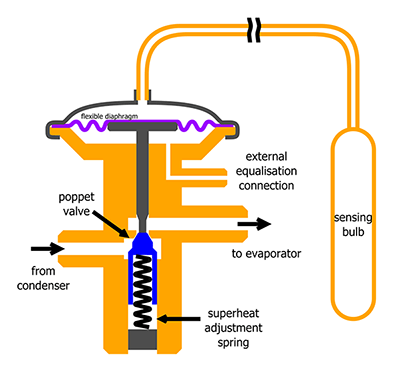For an air conditioner to work, there are four main components: a condenser, compressor, evaporator, and thermostatic expansion valve. These components work in tandem with one another in a loop system to produce cold air. If any of them is malfunctioning, your air conditioner will not produce cold air. Let’s take a look at how these components work together and how the thermostatic expansion valve plays a role in the process.
Defining What a Thermostatic Expansion Valve Is
In plain terms, a thermostatic expansion valve, commonly referred to as TXV, controls the amount of liquid refrigerant entering the evaporator at any given time. There are different types of TXVs, but they all work on the same basic principle and have the following parts:
- Orifice
- Setting spring
- Bulb
- Diaphragm
The Basics of How an Air Conditioner Works
Air conditioners work on the simple physics of changing a gas to a liquid. Within a closed-loop system is a refrigerant. Modern systems produced after 2015 use RF410A, also known as Puron, an ozone-safe hydrofluorocarbon. This refrigerant starts out as a gas in the compressor, where it is compressed between two solid objects. This creates a high-pressure, high-temperature gas called superheat. This superheat then works its way to the condenser that is located outside of your home.
Once this superheated gaseous refrigerant enters the condenser, the outdoor air absorbs the heat from the refrigerant. This reduces the temperature of the refrigerant and causes it to turn into a liquid.
The cold liquid refrigerant is fed into the evaporator at a controlled rate by the thermostatic expansion valve. A blower fan blows warm air over the evaporator, where the refrigerant absorbs the heat from the air. This causes the air to become cold, and a second blower fan blows the cold air into your ductwork, where it is then distributed throughout your home. As the refrigerant in the evaporator absorbs heat from your indoor air, it turns back into a gas and returns to the compressor to start the process over again.
How the Thermostatic Expansion Valve Controls the Amount of Refrigerant Entering the Evaporator
The thermostatic expansion valve relies on three different forces within the system: the evaporator pressure, bulb pressure, and spring pressure. The bulb is actually mounted on the evaporator. The purpose of the bulb is to sense the temperature of the refrigerant leaving the evaporator and to prevent liquid refrigerant from entering the compressor. It also tells the diaphragm when to open and close.
The bulb is composed of stainless steel and contains a refrigerant that is different from the refrigerant flowing through the rest of the system. When the refrigerant inside of the bulb increases in temperature, it also increases the pressure. This triggers the diaphragm of the valve to move up. The diaphragm is made up of a thin sheet of metal and a pin and is what controls the amount of refrigerant entering the evaporator. As the diaphragm moves up, it allows the cooled refrigerant to enter the evaporator as warm refrigerant exits. As the cold refrigerant enters the evaporator, the refrigerant inside of the bulb will begin to reduce in pressure. This causes the diaphragm to move down.
Inside the thermostatic expansion valve is a spring. This spring has a constant pressure that is calibrated by the manufacturer and counters the bulb pressure. As the evaporator pressure increases due to the refrigerant absorbing heat from your indoor air and turning it into a gas, so does the bulb pressure. As this triggers the diaphragm to move, the spring keeps everything constant and prevents large fluctuations in pressure. This keeps the pressure throughout the entire system consistent, which is essential in order to create a cold refrigerant and thus cold air.
Signs and Causes of a Malfunctioning Thermostatic Expansion Valve
A malfunctioning thermostatic expansion valve is one of the most misdiagnosed and overlooked parts of an air conditioner. This is because the signs of a failed valve are also common signs of other issues. This is one reason why it is so important to hire an experienced and licensed HVAC technician to troubleshoot your problem and perform repairs.
A thermostatic expansion valve that is not working properly and left unaddressed for too long can cause serious damage to the compressor. Replacing the compressor is very expensive and most often calls for a total replacement of the entire system.
There are several causes of a malfunctioning thermostatic expansion valve. Most commonly, a system that is not well maintained will get dirty. Dirt and water can work their way into the system. Once these contaminants reach the valve, they can stick to the orifices and cause the system to get stuck partially opened or closed.
If the valve gets stuck open, it will flood the system with refrigerant. The refrigerant will not be able to complete its process of absorbing heat and turning it into a gas because the pressure inside the system is not right. This can also result in liquid refrigerant getting into the compressor, which can ruin it. If it gets stuck closed, not enough refrigerant will enter the evaporator. In both cases, the system will not be able to produce cold air, and warm air will be coming from your vents.
To prevent this from happening, regular maintenance by a qualified and licensed professional is a must. When one of our technicians performs maintenance on an air conditioning system, they will clean the inside of the system, check refrigerant levels, and lubricate all moving parts. Cleaning the internal workings is essential in keeping dirt and water out of the thermostatic expansion valve.
Your Local HVAC Services Team
Troubleshooting a malfunctioning thermostatic expansion valve takes a lot of experience and knowledge. Someone that is inexperienced could end up costing you a lot of money in unnecessary repairs before the real issue is discovered. In the worst-case scenario, they might not find the issue in time, and you may end up having to shell out money to replace your entire system.
At We Care Plumbing, Heating, & Air, we know the importance of properly troubleshooting issues with heating and cooling systems. Our technicians are highly trained and knowledgeable. You can trust that we will take care of your system. If you’re experiencing issues with your air conditioner, trust the experts at We Care Plumbing, Heating, & Air. We have been serving the communities of Southern California for more than 20 years. If you reside in the Inland Empire, Orange County, Los Angeles County, Riverside County, or San Diego County, we have you covered.
We offer heating and cooling repair, maintenance, and installation. You can also trust us for all your plumbing needs, including drain cleaning, water treatment, septic tank, and sewer line services. Call us today at our office in Temecula, Murrieta, or Orange to learn more about our service offerings and to schedule an appointment.







